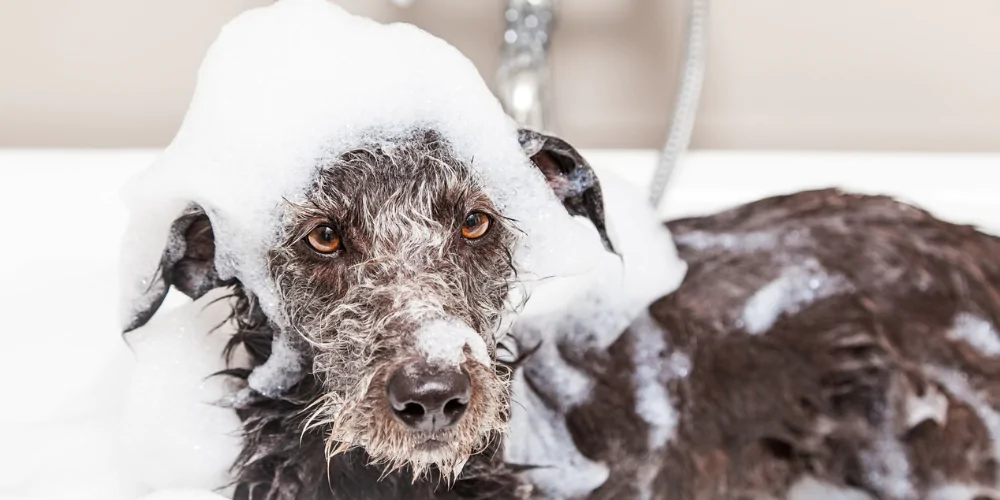
Ringworm in dogs: How to identify and treat

Dr Rachel Cox, FirstVet vet
8 September 2021 | 5 minutes read
While ringworm isn’t fatal, it can be an unpleasant and uncomfortable experience for you and your canine companion. FirstVet vet Dr Rachel Cox delves into how to identify the signs and symptoms of ringworm in dogs, as well as review the treatment options.
Table of Contents
- What is ringworm?
> How does a dog get ringworm? - How to know if your dog has ringworm
- How to treat ringworm in dogs
> How long does ringworm last in a dog?
> Dealing with ringworm in your dog - Can you get ringworm from a dog?

What is ringworm?
Believe it or not, ringworm isn’t a worm. It’s actually a fungal infection that affects your dog’s skin. It gets this name as the infection often results in a circular rash with a red ring. As well as dogs, other animals such as cats, rabbits, horses, and rodents can catch ringworm.
Ringworm typically infects broken skin on your dog. If your dog’s skin is healthy, it’s less likely that they’ll get a ringworm infection, but this isn’t a guarantee. The types of dogs that are most severely affected by the effects of ringworm are puppies, elderly dogs, and those that are ill.
Ringworm can need several rounds of treatment to clear it up, so the right cover for your dog will protect you from these unexpected costs.
> How does a dog get ringworm?
Ringworm is highly contagious. It can be spread to dogs either through direct contact with an infected animal or through surfaces such as pet beds, brushes or towels. It can live on these objects for up to two years, so if you suspect a ringworm outbreak, make sure you get on those gloves and clean these items.

How to know if your dog has ringworm
The most common symptoms of ringworm in dogs are fur loss and patches of inflamed, red, flaky, scaly or crusty skin, which is often in a ring shape.
You’ll more likely notice signs of ringworm on your dogs’ paws, legs, head or ears. Don’t be complacent, though! Ringworm symptoms can be found anywhere on their body.
Bear in mind that the symptoms of ringworm can be similar to other skin infections. We’re talking a resemblance to bacterial infections, yeast infections, and even allergies. Your vet will want to rule out these other skin conditions first.
If you spot any of these ringworm symptoms in your dog, contact a vet immediately. They can examine your dog and offer the right treatment for their condition. Your vet may use an ultraviolet lamp, called a Wood’s lamp, to look for signs of ringworm in your dog’s fur and on their skin.
Side note – this isn’t always used or 100% reliable as not all species of ringworm fluoresce.
Your vet will then take a sample of your dog’s fur (known as hair pluck) and possibly a skin scrape for culture testing in a lab. After all of this, it can take several weeks before you get back the results from the test.

How to treat ringworm in dogs
Mild cases of ringworm can sometimes clear up naturally, but it’s more common for untreated ringworm to spread to other parts of your dog’s body.
Once your vet confirms if your dog has ringworm, they will then prescribe medication. This can either be tablets, a cream or shampoo to apply to your dog’s skin. They may recommend a combination of these to get rid of the infection. Your vet may also decide to clip your dog’s coat in areas where there are ringworm patches, especially if the fur is long. This is to help the cream or shampoo to work more effectively, so your pooch may have to rock an interesting coat style for a little while!
> How long does ringworm last in a dog?
Thankfully, as we mentioned, there are several treatments for ringworm in dogs. It can take several rounds and many weeks, which means it can also be costly. As your vet will recommend treatment on an individual basis, how long the ringworm will last varies from dog to dog.
> Dealing with ringworm in your dog
When dealing with ringworm in your dog, make sure you wear disposable gloves and regularly clean any areas they come into contact with, such as carpets and sofas. Keep your dog away from any other animals to prevent the ringworm from spreading. Your infected dog will remain contagious for around three weeks after the treatment has started. Try to keep your dog to one room as this can help lessen the risk of ringworm spreading to other surfaces throughout your house.
Ringworm is known for returning to your dog, so keep a close eye for any familiar symptoms. Experts say that ringworm can return if your dog is feeling run down from another illness.

Can you get ringworm from a dog?
Yes, ringworm can be spread from dogs to humans. Ringworm in humans causes patches of red or inflamed skin. It can more often affect children and those with a vulnerable immune system.
You can catch ringworm either directly from your pet or through contaminated surfaces, such as their bedding or towel. Like with dogs, ringworm is mostly contagious to those who have broken skin, such as scratches and wounds, or a skin condition like eczema.
Contact your doctor if you think you may have ringworm and they will advise on the best steps to take.
Your dog deserves the best. That’s why we’ve created tailored dog insurance – and it’s really got tails wagging.


